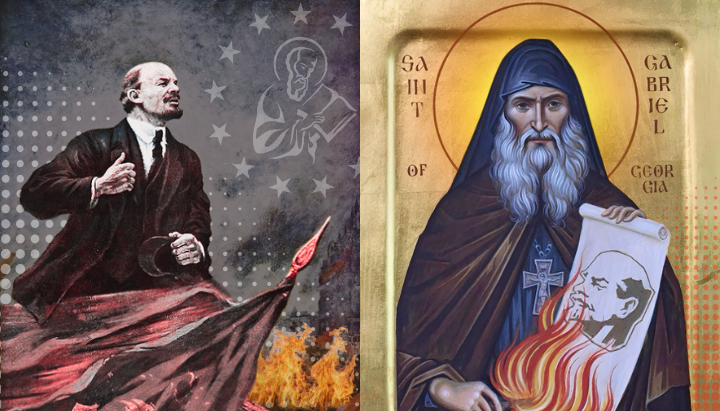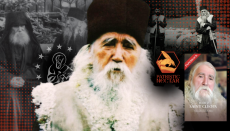Vladimir Lenin: Antichrist

Yesterday, the UOJ published an article by a freelance contributor, Luke Albanese, which expressed sympathy for Vladimir Lenin and the idea that he had a “truly Christian soul.” Furthermore, it attempted to frame St. Gabriel Urgebadze’s heroic 1965 burning of Lenin’s portrait during a May Day parade in Tbilisi as a mere protest against idolatry—a warning to Georgians not to “bow down before idols.”
We at the UOJ are committed to publishing a range of opinions on current events, history, and theology. We also encourage robust debate. And so I am here to offer the opposing view:
Lenin and his successor, Joseph Stalin, were Antichrists: enemies of the Church who, wittingly or not, did the Devil’s bidding.
I. Vladimir Lenin, Anti-Christian
Mr. Albanese's article leans heavily on dubious anecdotes to humanize Lenin: his wife Nadezhda Krupskaya claiming he opposed his own embalming and idolization; a supposed attendance at “Orthodox Christmas festivities” at Gorki (sourced from Stephen Kotkin’s Stalin: Paradoxes of Power, a secular biography that cherry-picks for drama); and, most egregiously, St. Tikhon’s statements allegedly praising Lenin and the USSR.
This is historical sleight-of-hand. Lenin’s actual record is one of unyielding hatred for Christ and His Church.
Consider his famous 1905 letter to Maxim Gorky. "Any religious idea, any idea of any god at all, any flirtation even with a god," he wrote, "is the most inexpressible foulness." He referred to “militant atheism” as a core Bolshevik principle.
Then there’s Lenin’s 1918 decrees, ordering the confiscation of church property, the execution of clergy, and the closure of monasteries.
Consider also his secret letter to the Politburo, sent in March 1922: “The greater the number of representatives of the reactionary clergy and reactionary bourgeoisie we succeed in executing for this reason, the better.” This sparked the 1922 show trials where Met. Benjamin of Petrograd was shot, along with dozens of priests.
As for Krupskaya’s “testimony” against idolization: Lenin himself approved the cult of personality in life. His embalming was pushed by Stalin, but Lenin laid the groundwork with his own mausoleum-like funeral plans and the deification of Marxist “saints.”
Moreover, any “dying wish” anecdote is simple hearsay. Other eyewitness accounts from doctors like Vladimir Bekhterev claim that the Soviet leader spent his final lucid moments ranting against priests. Certainly, no deathbed conversion is documented.
Unfortunately, the latter account is far more in keeping with Lenin’s life and thought. The fact is that Lenin devoted his life to eradicating Orthodox Christianity—and all religion—from Russia and the world.
As for St. Tikhon’s statements, these must be read in the context of the unimaginable pressure he faced from Soviet authorities. The Patriarch was under house arrest. His Church was ravaged. His 1918 anathema against the Bolsheviks condemned their “satanic” deeds. The statements he issued during this period (e.g., the 1924 Evening Moscow article that Mr. Albanese cites) were almost certainly tactical. St. Tikhon was hoping to avoid the total annihilation of Orthodoxy amid the Renovationist schism engineered by the GPU.
St. Hilarion Troitsky defended Tikhon’s humility. But remember, he too was martyred in Solovki, a victim of the Marxism-Leninist ideology. In any event, it’s highly probable that St. Hilarion was also adopting a conciliatory attitude toward the Soviet authorities.
And of course, on January 19, 1918 (O.S.), St. Tikhon pronounced an anathema and excommunication against the Bolshevik leaders as persecutors of the Orthodox faith, condemning their violent seizures of power, killings, and attacks on the Church as satanic acts. He never revoked the anathema. Does it sound like St. Tikhon truly warmed to Lenin?
II. St. Gabriel, Anti-Communist
Mr. Albanese claims St. Gabriel did not burn the flag out of hate or judgement of Lenin, but rather as a protest against idolatry. And surely St. Gabriel would not allow feelings of hatred towards a fellow human to enter his heart. Still, the context of the act and the Church traditions surrounding St. Gabriel make it clear that he was, indeed, an anti-communist.
On May 1, 1965, as a massive Lenin banner hung over Tbilisi’s parade, St. Gabriel climbed the platform, doused it with kerosene from a hidden bottle, and set it ablaze. He shouted: “Glory to Christ, not to Lenin! Lenin belongs in hell, not in the place of the cross!”
The sermon he gave from the balcony invoked Exodus 20, targeting the Soviet system: “You bow to a dead man instead of the living God! Christ is risen, but Lenin rots!”
Mr. Albanese is also correct that, as Khrushchev’s “de-Stalinization” intensified, so did anti-Church campaigns: 10,000 churches closed between 1958–1964. Seminaries were shuttered. Believers were imprisoned. St. Gabriel, beaten nearly to death by KGB thugs and declared “insane,” mirrored the New Martyrs who died crying “Christ is Risen!” against Bolshevik firing squads.
The idolization of the paramount leader is, indeed, a grave error at the heart of communist ideology. Yet it is only one error of many. To reduce St. Gabriel's gesture to “warning about idolatry”—as thought it could somehow not also be a protest against communism more generally!—ignores the banner’s symbolism.
Lenin was the chief deity of the communist pantheon. St. Gabriel burned the core emblem of this demonic "faith," echoing the Royal Martyrs’ refusal to compromise with evil.
The Church herself has consistently emphasized the anti-communist nature of St. Gabriel’s demonstration. His akathist refers to him as a “victor over godless authorities.” It also says, in no uncertain terms:
But thou, not fearing death, didst burn the image of the idol God-hater and servant of Satan as if it were a whole-burnt offering to God, and for this audacious deed the authorities possessed unrivaled hatred for thee…
III. Revisionism and Iconoclasm
Lenin was an Antichrist, responsible for the Red Terror, among other atrocities. It is estimated that nearly 3,000 clergy and 5,500 monastics were murdered on his orders, along with over 8,000 laymen. He never repented of these crimes. The title attributed to him by the akathist to St. Gabriel—God-Hater—is, sadly, more than suitable.
I couldn’t end this article without noting how Mr. Albanese speaks of the “so-called crimes” committed by Joseph Stalin—as though to suggest that Stalin was not a criminal at all. I would refer the reader to Fr. Josiah Trenham’s masterful video, Stalin: Architect of Death, published in response to another apologist: Nick Fuentes.
We would also note the brilliant statement issued earlier this year by the Holy Synod of ROCOR warning against the spiritual and political dangers of neo-Soviet ideology. Because, unfortunately, Mr. Albanese's view is not unprecedented.
Since the fall of the Soviet Union, certain Russian nationalists have attempted to "reinterpret" the history of the Soviet Union to downplay its anti-Christian elements. This revisionist history creates an historical narrative—a national "story"—that is acceptable to both the millions of Russians who have returned to (or never abandoned!) the Orthodox Faith and the millions who remain loyal to the memory of the Soviet Union.
Whatever Russians might wish to tell themselves, Orthodox Christians in the United States of America need not and cannot defend the memory of these God-haters, these Antichrists.
St. Gabriel burned Lenin’s image to proclaim that Christ alone is King. Let us burn any hateful icon of God-haters and Antichrists that may hang in the dark corners of our hearts.









